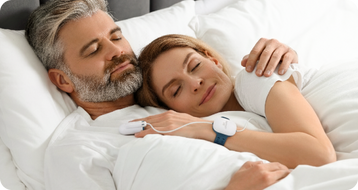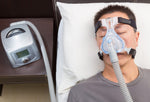On This Page
How Long Does a CPAP Machine Last?
Our editorial process includes extensive measures to verify accuracy, provide clarity on complex topics, and present factual information. Read more
Key Takeaways
- CPAP machines typically last about five years
- Regular cleaning and replacing parts can help your CPAP last longer
- Most insurance will cover at least a portion of the cost of a replacement CPAP
Average CPAP Machine Lifespan
Most continuous positive airway pressure (CPAP) machines last approximately five years. The lifespan of a CPAP machine can vary depending on the make and model, how often it’s used, and whether it’s properly maintained. Some models may only last three or four years, while others have been known to last longer than 10 years.
How long a CPAP device lasts depends largely on its materials and design. Cleaning and replacing components as needed can help extend its longevity. Though heavy use may shorten the lifespan, it’s still important to use the device nightly as prescribed by your doctor.
Most CPAP machines age gradually, but some models experience a sharper drop in functionality around the three- to five-year mark. More rarely, a CPAP device may be recalled by the manufacturer due to a safety or performance issue.
Signs Your CPAP Machine Needs to Be Replaced
Keep your eyes peeled for any of the following as indications that it’s time to buy a new CPAP machine.
Your Machine Is Noisy
All CPAP machines make a consistent whirring sound that’s usually easy to ignore. If you notice your machine making new sounds, especially while inhaling, it may be a sign it needs to be replaced. Before a full machine replacement, it’s a good idea to get a new mask and/or tubing in case either of those components is worn out and not the machine itself.
Your Machine Is Losing Pressure
A worn-out machine may not be able to deliver air pressure at the correct rate. If you have used your CPAP machine for a while, you’ll likely notice the difference if the airflow changes. First, check to make sure your mask is fitting correctly, and then look into replacing your CPAP machine.
The Machine Will Not Turn On
Your CPAP machine not turning on or staying on is a sure sign that something is broken. You may also notice that the digital display isn’t visible or working correctly. Reach out to the manufacturer to check if it’s possible to repair the power supply. If not, you’ll need a new machine.
You See Damage
Cracks and other damage may indicate that you need a new machine, but it’s also possible to replace individual parts. Humidifier water chambers usually need to be replaced every six months, and some manufacturers are able to replace power cords.
The Humidity Level Changes
If the air from your CPAP feels dryer than usual or if the water level in your humidifier’s water chamber isn’t going down as quickly as it normally does, it may be time to replace your humidifier. Before buying a new one, first check that the heating element is working and that the heat settings are correct.
Your Symptoms Return
If any of your sleep apnea symptoms return, it’s a good indication that your machine is not working properly. You or your sleep partner may notice snoring, or you may simply begin to feel less rested. Check with your doctor to see if your machine is calibrated correctly or if it’s time to invest in a new machine.
Your Machine Is Overheating
Overheating is usually because of a malfunction and not normal, even for an aging machine. If your machine feels overly hot to the touch, and especially if it’s smoking, you should unplug it immediately. Reach out to the manufacturer to see about getting a replacement, and consider reporting the issue to the U.S. Food and Drug Administration (FDA).
How to Make Your CPAP Machine Last Longer
Regularly cleaning your CPAP machine, replacing parts as needed, and familiarizing yourself with the warranty terms can help reduce the chances of premature damage.
Clean on a Schedule
Cleaning your CPAP machine’s components helps keep out allergens and bacteria, and prevents unnecessary strain on the device from dust and dirt.
Check your user manual for instructions on how to clean your CPAP machine. Different components may need to be cleaned on a daily or weekly basis. Most manufacturers recommend using warm water and mild soap to clean CPAP masks, tubing, and humidifier water chambers.
Avoid using ultraviolet light and ozone cleaners, as the FDA has issued a warning about their safety and efficacy.
Replace Parts Regularly
To keep the machine working properly, replace the filter, mask components, tubing, headgear, and the humidifier water chamber on a regular basis according to the manufacturer’s instructions.
| Item | Replace Every |
| Nasal mask cushion or pillows | 1 month |
| Full-face mask cushion | 1 month |
| Mask frame | 3 months |
| House and tubing | 3 months |
| Headgear | 6 months |
| Chin strap | 6 months |
| CPAP machine filters | 1 month (disposable), 6 months (reusable) |
| Humidifier water chamber | 6 months |
| Heated humidifier | 5 years |
| CPAP machine | 5 years |
Know Your Warranty
Most CPAP warranties cover material and workmanship defects during the first two years after purchase. Read the warranty terms and follow the cleaning, usage, and maintenance instructions to remain eligible for coverage. If an issue comes up, submit a claim as soon as possible.
Insurance Coverage for Replacement CPAP Machines
Most insurance – including private insurance, Medicare, and Medicaid – will cover the replacement of a CPAP machine. It’s a good idea to check your specific plan for any requirements or timelines, but insurance will generally cover replacement if a machine is lost, damaged beyond repair, or has reached the end of its useful life.
How Often Does Medicare Cover a New CPAP Machine?
Medicare covers repair or replacement of CPAP machines after five years. There are a few other guidelines depending on your situation:
-
If your original device was covered by Medicare and is lost or damaged before it hit the five-year mark, Medicare will replace your CPAP with no need for a new medical evaluation or sleep study.
-
If your original device was covered by Medicare and is five years old or older, Medicare will replace your CPAP with no need for a sleep study, but your doctor must confirm that you still need and use the CPAP machine.
-
If your original CPAP was not covered by Medicare, Medicare will replace it as long as you have a medical evaluation and a new sleep test.
Coverage under state Medicaid programs or private health insurance plans may vary.
Can You Use an FSA or HSA to Replace Your CPAP Machine?
Flexible spending accounts and health savings accounts are designed to help cover medical expenses and should be eligible for use toward replacing a CPAP machine. Before allocating funds to replace a CPAP device, confirm eligibility with your FSA or HSA plan provider.
Frequently Asked Questions
If your old CPAP machine has been well maintained and is still in good working condition, then it may be acceptable to use as a backup. You should not use a machine with broken parts or a device that is not properly calibrated, as these do not provide effective treatment for sleep apnea.
CPAP machines are designed to work well until they are ready for replacement. There may be a slight dip in performance over time, but when they become noticeably less effective, you should replace faulty parts or get a new machine.
Certain charitable organizations and medical equipment companies accept donations of used CPAP machines, providing they meet certain criteria. You may also be able to sell to an authorized reseller or dispose of a used CPAP machine at local recycling facilities.









